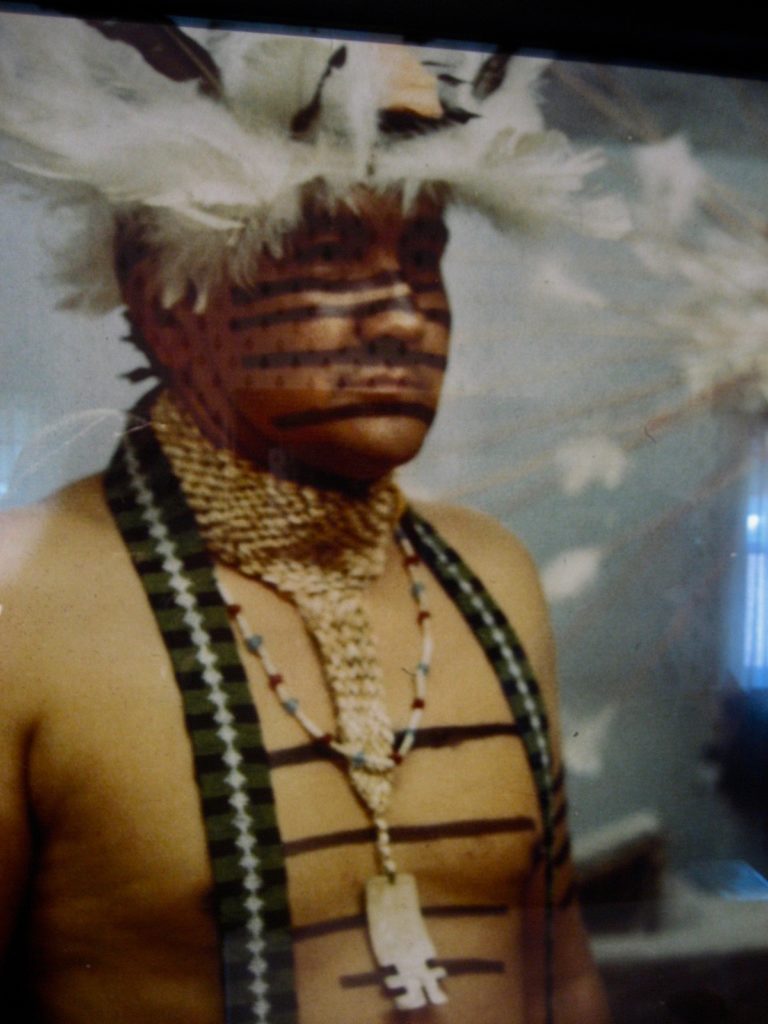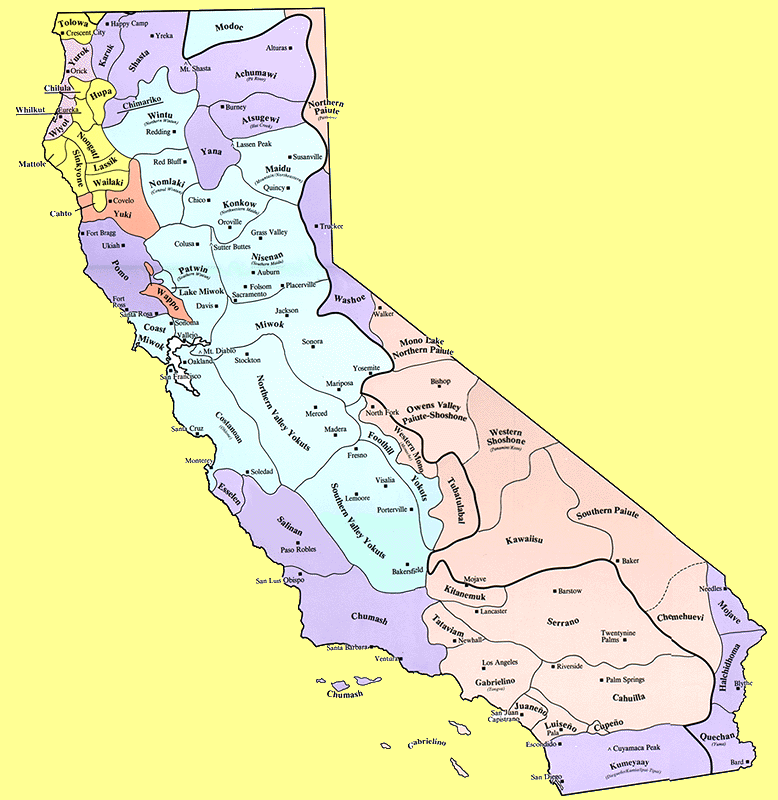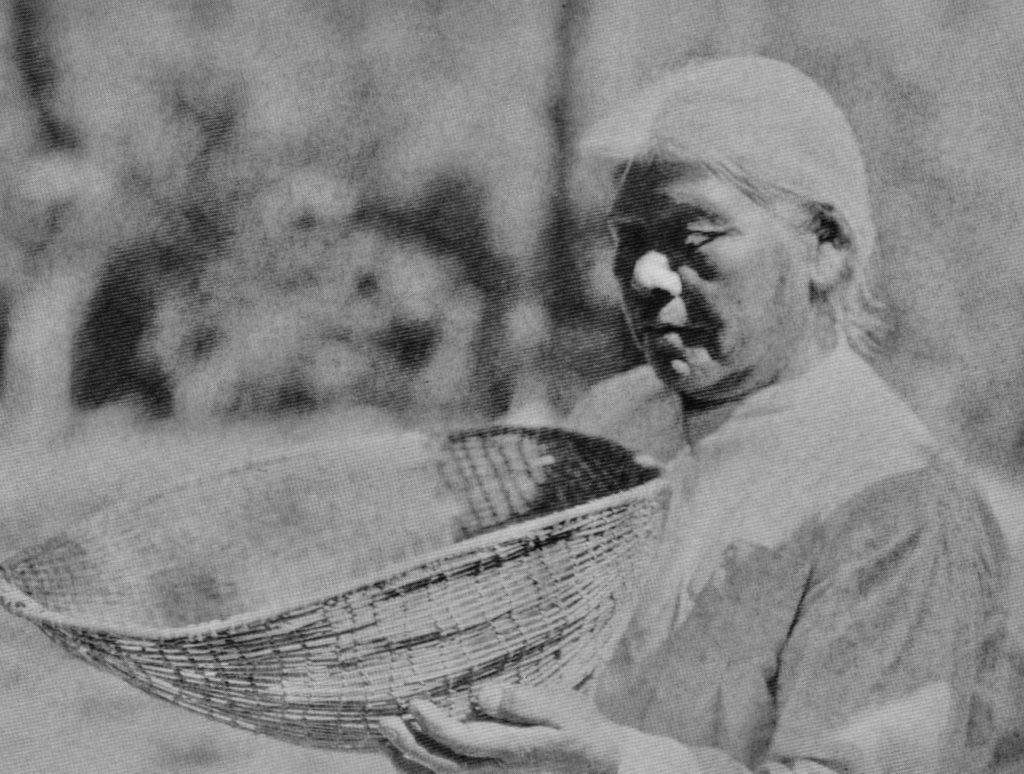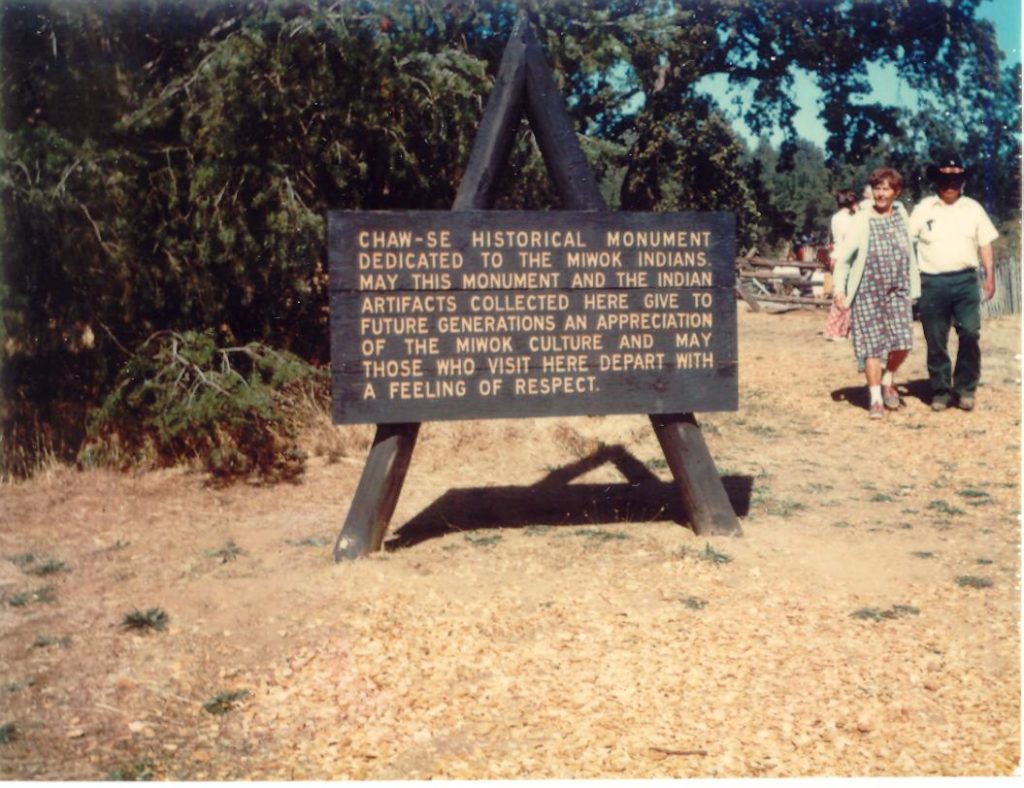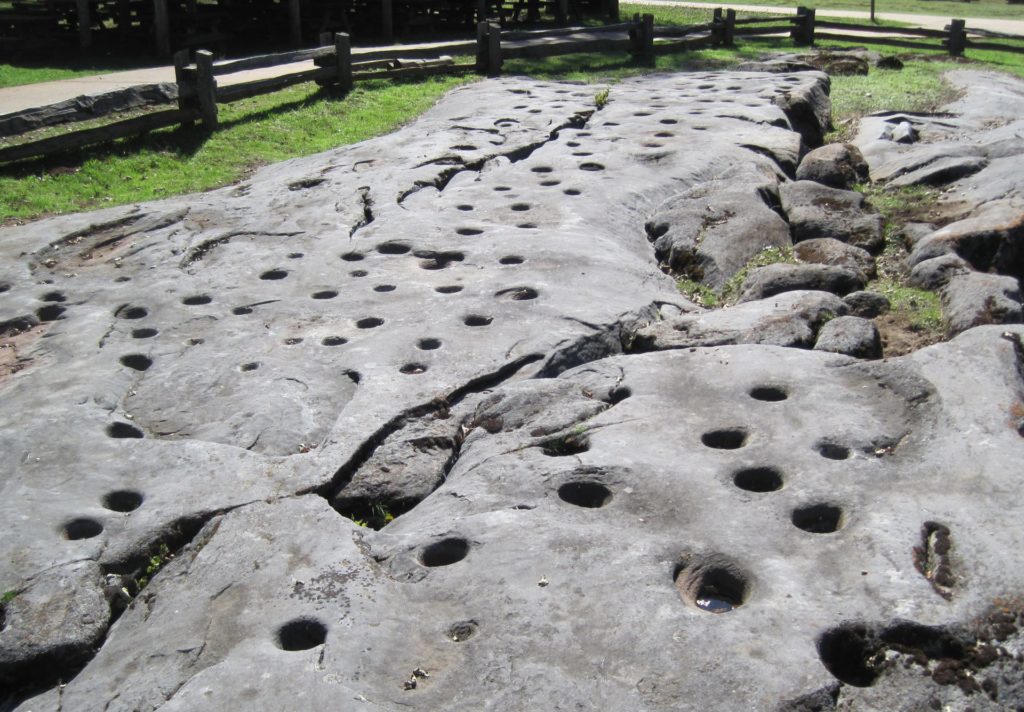Archeologist Dave Stuart spoke to the Elk Grove Historical Society at one of our monthly history presentations and said scientist and historians have evidence that makes them believe humankind came to North America from the north about 38,000 years ago. Over time, cultures grew and upon the arrivals of the Europeans in the late 1400’s they found many tribes of Native Americans populating the land.
As in your many readings and as Hollywood has shown many Indian cultures were similar, yet, they were different. Tribes were often moving depending on weather, shelter, food availability, natural game, and religious customs. A perfect example were the local tribes, mostly Miwok, which are associated with our region.
Wikipedia gives an overview…
The Miwok Indians are a tribe of Native Americans who lived primarily in Northern California, and most of their tribal ancestors are still in that region today. Before the arrival of European settlers, these people lived throughout the coastal and mountainous regions of Northern and Central California, including some parts of what is now southern Oregon and Western Nevada. There were two main branches of the tribe, divided primarily with regards to where they spent the majority of their time, namely inland or on the water. Both were primarily hunter-gatherers, and they lived in semi-permanent villages known as “Rancherias” that could move if need be to follow food sources. The United States government removed the people of this tribe to reservations in the mid-19th century, which put a virtual end to the Rancherias. Many Miwok still live on government-sponsored reservations today, and often are very involved in keeping elements of the old culture and belief system alive.
Early Tribal Life
The Miwok traditionally lived in small groups or villages run by a male leader called a headman. Leadership followed family lines, typically from father to son. In situations where a headman had no sons, his daughter would be known as the headman — but a male relative would perform her leadership duties.
They lived together in small groups, sleeping in structures just big enough to cover the family and a small fire. Large villages had a shared shelter, usually known as a “round house,” which was used for ceremonies and other important gatherings. During festivities, the members of a community would sleep together in the round house.
Main Branches
There once were two main branches of Miwok, the “land” and “water” tribes. Early groups fall into four general categories — Coastal, Lake, Bay and Plains — although there were also a large number of individuals who lived in the Sierra Mountain range. In fact, Yosemite National Park was the summer home of one such group, and Yosemite takes its name from “asamati,” the Miwokword for “bear.”
Culture and Diet
This group of Native Americans were have said to have eaten every living animal for food, but this is not quite true. While less common animals, such as the skunk, bat and grasshopper, were staples of their diet, the tribe did not typically eat king snake, rattlesnake or grizzly bear. Their diet varied greatly by location, but along with fish and large and small beasts, they also ate nuts, fruit, bulbs and roots.
Traditionally, like many Native American tribes, the Miwok enjoyed a variety of games. Some would be described as sports, often played in mixed groups of men and women. Others could be considered gambling or games of chance, such as an acorn throwing game played among women.
Typical attire consisted of deerskin loin cloths for both men and women, with longer tunic pieces and calf-high boots reserved for the coldest periods. Men and women let their hair hang loose or bundled it at the nape of the neck. Both sexes enjoyed piercings in the nose and ears. The MiwokIndians also traditionally sported tattoos on their foreheads, cheeks, chins and chests. They had their own language with a few regional dialects, and the word “Miwok” actually means “people” in the main branch of Miwokan.
Displacement and Interactions with European Settlers
Disease, fighting and enslavement by early Spanish and Mexican explorers destroyed great portions of the tribe’s culture. During the 1800s, their population was estimated to be about 20,000. By 1990, the United States Census showed 3,500 Americans with Miwok ancestry. Only 500 lived on the Rancherias that were speckled throughout California at that time.
Treaties and U.S. government programs established a number of permanent sites for the Miwok Indians to call home, but most of those sites were overtaken by settlers or abolished by various government agencies between the 1920s and 1960s. During the late 20th and early 21st century, eight Rancherias reclaimed or solidified their recognition. These are Buena Vista, Chicken Ranch, Ione, Jackson, Middletown, Sheep Ranch, Shingle Springs and Tuolumne. At one point the different Rancherias had distinct identities, but most modern government programs and classification rubrics group everyone with Miwokean lineage together and treats them as equal.
Modern Recognition
Like many California tribes, the Miwok fought for and won recognition as indigenous people of the state and enjoy their own land rights as a consequence. In most cases, life on the reservation isn’t all that different from life in regular society. The tribes don’t usually live in shelters anymore, and they don’t typically wear traditional clothing except for special events or tribal rituals.
Despite their protected status, though, many Indians became indentured servants as settlers moved into the area. This is reflected in the largely agricultural nature of their population. The government has taken steps to correct past wrongs, and provides a number of financial and educational incentives to tribal members who want a different life. A number of Miwoks have gone on to be leaders in both the local and national communities, but the majority tend to live in poverty or near-poverty today.
Local historian, Elizabeth Pinkerton wrote in her History Happened Here, Book-1, Chapter-3; “They Were Here First – The Miwok People.” in 1999……
An Introduction by Matt Franklin:
Miwok Indians have always made their home in what we now call Elk Grove, Wilton, south Sacramento, and the Coastal area, and they lived and migrated as far south as Yosemite. Today we use what area we are from to describe ourselves, such as the Wilton Rancheria Miwok and the Ione Band of Miwoks – two local groups that are referred to by their federally recognized names. Miwok people referred to themselves by their local rivers and physical and geographical locations. People north or south of the river called themselves Umne, the people of the river.
Although many people think that Miwok people no longer live here, descendants of local tribes still carry on their tribal customs and histories. As a traditional Miwok dancer, educator, and tribal leader, I hope to see more people understand the way of life the Miwok people had and the obstacles they had to overcome to survive.
Mr. Franklin, a graduate of Elk Grove schools, is the Indian Program Educator for the Elk Grove Unified School District. He attends California State University, Sacramento, and he is the elected vice chair of the Ione Miwok tribe.
You may have wondered about the similarity in these three names; Cosumnes, Mokelumne, Omochumne. We credit the Miwok Indians for all these place names, because the names came from the first residents of what we now call Elk Grove and South Sacramento County. When the first Spanish explorers came to this area in the early 1800s, they found many groups of American Indians in this part of California. These native Americans lived along the Cosumnes River and the little creeks and waterways that thread their way across present day Elk Grove, Laguna Creek, Franklin, Wilton, Sheldon, and Sloughhouse.
Gabriel Moraga, the Spanish explorer of the early 1800s, estimated the number of Miwok people living in the Cosumnes region at that time as being at least 11,000.[i]There were many, many villages, and often there was a large village surrounded by small satellite villages. The head people, the leaders, lived in the large village, and there was a structure that held the large groups together. The area around the Cosumnes River had plenty of food, especially acorns and salmon. Because of the ample food supply, large numbers of people could be sustained.
The Miwoks were the first people to live along the Cosumnes River as it winds its way down from the high country of El Dorado County to the flatlands south of Elk Grove and Franklin. Somewhere out there in the sloughs west of Highway 99, in the Franklin area, the Cosumnes joins its sister river, the Mokelumne. Together, the two great rivers rush on until they become one with the mighty San Joaquin. Along all three of these rivers were the homes of many Miwok people. The traditional boundaries of the Miwok tribes were between the Cosumnes River and Yosemite.
Those who study the past, such as ethnographers and archaeologists, refer to all these tribes as Plains Miwok, and they know that these people lived primarily along the Cosumnes and Mokelumne rivers. There were also Coastal Miwok, Great Valley Miwok, and Sierra Miwok. The Miwok history is somewhat obscure, and even though there were seven major languages, we are able to piece together what life must have been like before the Gold Rush forever changed the great valley of California.
Though there were many Indian tribes in the region, and their dialects were different, there were many more similarities than differences among them. The various Miwok people were able to communicate and understand each other’s language, something that many other tribes could not do. This skill, along with their ingenuity and ability to adjust to new situations, served the Cosumnes River Miwok people well.
The rich plains and the many rivers full of fish – Cosumnes, Mokelumne, Stanislaus, Tuolumne, Merced, Chowchilla, and San Joaquin – provided for a rather dense population. The Miwok nation was the largest American Indian group in California, both in geographic size and in the numbers of its people. Numerous archaeological sites in the area from Franklin to Rancho Murieta have provided us with valuable information about the Miwok. Of great significance was the spectacular find in the 1930s on what was then the Windmiller Ranch on Grant Line Road. The culture known as Early Horizonevidence of the first settlers of the Sacramento Valley, was found at this site. Clearly, there were Miwok people living along the Cosumnes River more than 4,000 years ago![ii]
There are two versions of the origin of the name Cosumnes – one, of course, is the Miwok word for salmon, kosomor kossum. The other comes about from the following: Omo,rock or rocky; chumna,rushing river;umna,river; Cos’os,all the people. That is how we get Cosumnes, a reference to all the people of the river.
An indication of the great number of Miwok who were relocated to Mission San Jose from the Cosumnes River area can be found in the research of Brian Bibby.[iii]Between 1811 and 1836, according to Mr. Bibby, therewere 2,000 baptisms at Mission San Jose. It was not unusual for entire villages to be emptied of their inhabitants – all were captured and taken to the Mission. In 1826, an explorer of the area reported 40 Miwok houses abandoned south of the Mokelumne. He found children hiding in the tules and took them to Mission San Jose. A major Miwok village was known as Cosumne, east of where the Cosumnes River emptied into the Mokelumne River, south of Franklin.
Luis Arguela headed an expedition from Mission Dolores (San Francisco) and found the Miwok ready to take a stance at the mouth of the Cosumnes.[iv]A major battle ensued there in 1820, and the Miwok took possession of Spanish horses. Laws were later passed to prevent Miwoks from riding horses due to the fear that they would mobilize. In 1826, the Spanish destroyed the Miwok village known as Cosumne. Although more than 40 villagers were taken prisoner, and at least that number killed, the Miwok people continued their resistance against the invaders. They banded with the neighboring villagers at Ylanme (near where Clarksburg is today), and they joined the Mexicans at a time when the Spanish were vulnerable. Two mighty enemies were yet to emerge, however, and these the Miwok could not conquer.
The first of the terrible enemies of the Miwok was Disease. Smallpox, brought to the area by Hudson Bay trappers who were camped near Sutter Buttes, did not take long to make its effects known. A village between the communities we know of today as Sloughhouse and Elk Grove, was hit by a devastating malaria epidemic. Villagers who had managed to survive the Spanish soon succumbed to these two deadly diseases.
The second devastating enemy of the Miwok people was John Sutter, the ambitious, self-proclaimed captain who set up camp at the confluence of the Sacramento and American rivers and began the settlement that evolved into what we know of today as the city of Sacramento. Sutter saw the Miwoks as a threat to his taking over of their territory. He killed 30 Miwok people at Cosumne and signed a treaty with those who were left. He then moved the survivors to the American River where he used them for his private labor force, and other villages unfortunately suffered the same fate.[v]
Many Miwok families, along with those who escaped from the missions, fled for safety to the foothills. There, they were able to exist without constant fear of invaders. The numbers tell the story though – in 1808, Moraga had estimated a Miwok population of 11,000, but the 1846 census listed only 59 Miwok people at Cosumne. It is likely that that other villages had similarly been decreased, and those who had fled to the foothills were not included in the census. The coming of the European and American explorers and settlers was clearly in conflict with the lives of the people who were living here when they came.
In the half-century, between 1800 and 1850, the Miwok lifestyle and culture almost disappeared. The few hundred Indians that remained in the valley could no longer follow their traditional way of existence because the environment they depended upon had undergone dramatic changes.
When the Gold Rush came, the Miwok way of life was threatened once again. And, when there was no gold left in the streams, new settlers came, and the Miwok culture became more and more endangered. As lands began to be used for agricultural purposes, it became increasingly difficult for those who had been here first to escape the conflicts with their new, uninvited neighbors.
When the mountains, valleys, and prominent landforms of the Sacramento Valley were charted and named, both Miwok and Spanish names were used to designate various locations.[vi]In some instances, the Indian names were converted to Spanish, and that is how we happen to have many of the names we use today.
Ellen Rosa, our valued collector of Cosumnes history, has a copy of the Omochumnes Land Grant that was obtained by Jared Dixon Sheldon in 1844. This is the description of the area between Grant Line Road and the Cosumnes River:
“Terrenos altas con poco pasto; Lomerias esteriles pedregosas. five Sitios de grand Mayor between the north side of the River Cosumnes, the Rancheria of the Omochumnes, the rocky hills, and the pass which at said River leads to Mr. Sutter’s establishment.”
Translated, the first part means they are referring to high land with little pasturage and rocky, infertile hills. They may have been infertile and rocky hills, and sounding a lot like useless land, but those hills had a most colorful and productive past as the homeland of the Miwok people. The word Omochumnes comes from omomeaning rock or rocky area and chumnes, the Spanish version of chumna. Roughly translated, the grant states something like “the ranch on and near the rocky, infertile hills beside the rushing river.”Both the Indians and the Spanish had seen the Cosumnes River flood from hilltop to hilltop west of Bridge House, so it would be natural for them to call it rushing in the wintertime.[viii]And they will continue to have a colorful and productive future as suburban growth of south Sacramento County.
Imagine the variety of wildlife in the quiet, beautiful days before freeways and subdivisions. There were deer, antelope and tule elk roaming freely throughout the area, and squirrel, rabbit, wildcat, quail and geese. In the rivers could be found trout and many other fishes, including. There were abundant supplies of salmon from which it appears that the Cosumnes River received its name from the Miwok kossum. There were many varieties of acorns, and seeds, bulbs, manzanita berries, mushrooms, corn, wild onion, elderberries, clover, buckeye, tule roots and spears, and watercress. In the maze of sloughs and marshes that we have learned to love, and on the rolling flatlands that we are populating with houses, were a diverse plant and animal life that supplied everything the Miwok men, women and children needed. The fertile valley, marshes, and grasslands were like today’s supermarkets where food, clothing, and housing needs could be obtained. And that is how it was for thousands of years – until the middle of the 19thcentury.
Ric Windmiller, (EGHS ’64) Elk Grove’s expert on Miwok culture, described the Miwok reliance upon the oaks of the Cosumnes Valley in an article for the Elk Grove Citizen:
“Miwok people gathered acorns after the August burning – when dry grass was torched to ensure next year’s seed crop. During late fall and early winter, gatherers knocked acorns from valley oaks with various kinds of poles. Acorns were also picked from the ground after being allowed to ripen and fall naturally. The foragers commonly transported acorns to their villages in conical-shaped burden baskets.
“Harvesting a plentiful crop some miles from camp prompted immediate construction of a granary – temporary storage for the windfall until convenient to carry to the village. Forked branches of a tree, out of reach of browsing animals, afforded an ideal site for the wilderness granary. A pole laid across the branches served as the foundation for a finely crafted wicker-work, a cylinder of willow stems. Thatch applied to the willow frame completed the granary – usually it was three to four feet in diameter and six to eight feet high.”[ix]
Seven varieties of oak trees are native to the Cosumnes River, and on these the Miwok depended for their main food supply. There were little bushy scrub oak, large scrub oak, post oak, live oak, white oak (also known as valley oak), water oak (known also as swamp oak and blue oak), and black oak, the preferred oak for acorns.[x]
Acorns were collected in the fall and placed in large woven baskets that had been made from grasses. After shelling, the acorns were ground into meal with stones. The meal then had to be leached to remove the bitterness and harmful substances, done by placing the acorn meal into a hole in the ground. The hole was lined with pine needles, and for many days, water was slowly poured into the hole. Eventually, the acorn meal was ready to eat. Mush, bread and a kind of pudding were all made from acorn meal. Cooking was ingenious, considering that it was done in a basket over an open fire. The cooking baskets were woven from grasses, reeds and branches, and if the cook were not careful, the dinner would perish over the blazing fire. The method that was used was to heat stones and then carefully place them in the water in the basket. When the water bubbled, it was time to put the meal in, and then it had to be stirred continuously until it reached the desired thickness. Acorn soup, acorn mush, acorn bread… as long as there were plenty of acorns along the Cosumnes, Miwok families thrived along their river homeland.
The best examples of Miwok culture in this area are at Chaw’se, Indian Grinding Rock State Park, located in Pine Grove, east of Elk Grove and Sloughhouse.[xi]The grinding rock (that’s what Chaw’se means in Miwok) is a huge, natural outcropping of limestone. The unique feature of the rock is the hundreds of indentations, all over its surface. They are mortar cups, and there are said to be 1,185 of them, the greatest number found on a single rock in California. This is where Miwok families came each fall to grind their acorns into meal. They used stone or wooden pestles, and when the hole got too deep, they simply started another. That’s why there are so many indentations.
At Chaw’se you can also see examples of Miwok structures. The roundhouse is the largest in California, built cooperatively with the local Miwok community headed by Elder William (Bill) Franklin.[xii]Oak posts, cedar poles, grapevine bindings, and the cedar bark roof reflect the traditional Miwok methods of construction. The bark house is made of cedar poles and bound with grapevines. A hole at the top of the wikiupallows smoke to escape from cooking and heating fires. The acorn granary is designed to hold up to 2,000 pounds of acorns, enough for a family for a year. Poles placed around a hollow stump are tied with grapevines. Cedar branch thatch covers the granary, and inside, a lining of wormwood discourages insects and rodents from taking a share of the food.
Special features at Chaw’se are the rock carvings that are properly called petroglyphs. There are more than 300 of them, and they are wonderful examples of Miwok design even though they are eroded and hard to see. Surrounding the grinding stone are the many wildflowers that once covered the Sierra Nevada foothills and the Sacramento Valley. The seeds of buttercup, tarweed, and farewell-to-spring were ground into meal. Brodiaea bulbs were steamed and eaten. Bulbs of soaproot were turned into soap, glue and brushes. Bushes also became food for manzanita made tasty cider, and blue elderberries, wild grapes and blackberries were eaten raw or dried for use in winter.
Unfortunately for Californians, the real treasures of Miwok culture cannot be found in California. Amazing and wonderful creations of the Cosumnes River Miwok people are not where you might think they would be. They are stored in a museum, which is good, but the museum is in a strange place – the city of St. Petersburg in Russia. [xiii]How can that be?
The explanation is simple. If you recall your California history, you will know that it was the Russians, who were the first Europeans to come to the northern California coast. These Russian explorers traveled inland to the area known today as Laguna West and Stone Lake in search of fur bearing animals. This accounts for the Russian trade with the Miwok people of the Cosumnes. Isn’t it amazing?
In addition to St. Petersburg, museums in Frankfort and London also have Miwok artifacts, and there are some at the Smithsonian Institution in Washington D. C. too. But, if you want to see the real treasures, you will have to go to St. Petersburg. In that museum, you will gaze with wonder at a magnificent condor feather cape, unlike anything you have ever seen. You will see a spectacular and wondrous belt, six feet long, intricately woven of natural fibers, shells and red woodpecker feathers. You will wonder, of course, why you had to travel so far away from the Sierra foothills, the home of the Cosumnes River Miwoks, to look upon their amazing works of art! Perhaps some day, these treasures will come home to Franklin, Sloughhouse and Elk Grove.
Today, the voice of the Miwok people is alive and well along the Cosumnes River. Efforts are taking place to have the Wilton Rancheria brought back to its status as federally recognized Indian tribe.[xiv]Miwok families protested the loss of burial rights at the Hicksville Cemetery, claiming that portion of that country cemetery had been given to them by Count Pio Valensin in the late 1800s. (see chapter 18)[xv]
Another active part of the Miwok culture is within the federally funded Indian Education program of the Elk Grove Unified School District. The program’s purpose is to assist American Indian youth with academics and the preservation of their culture. Matt Franklin, who happens to be the vice chair of the Ione Miwok tribe, is the person in charge of the program, and he works with students and their families – not just Miwok, but any who have American Indian tribal affiliation. Mr. Franklin is a third generation member of the Bill Franklin family and a 5thgeneration member of the Aleck Blue family. He attends California State University, plans to become a teacher, and is committed to carrying on the cultural values of the Miwok people.
In the summer of 1999, Matt Franklin was recognized as the youngest elected official of a tribal government and had the honor of sitting on a stage with President William J. Clinton at a national gathering in Chicago. In January of 2000, he was recognized as a Distinguished Graduate of California schools by the Elk Grove Unified School District and by the California Department of Education. These are fine tributes to the first people who lived in the Elk Grove area.
If anyone can bring the Miwok treasures back to South Sacramento County, it will be this new generation of Miwok men and women. Grounded in the past as a result of the teachings of their parents, they are also clearly focused on the present. Most important of all, these young people, guided by no only by parents, but by grandparents as well, have an unmistakable vision for their future.
There is much we can learn from the people who walked these paths before us. Let us be mindful of our collective past as we focus on today, and as we work together for the future – along the Cosumnes River in south Sacramento County.
